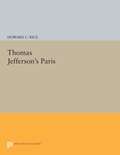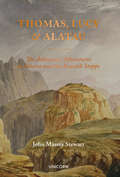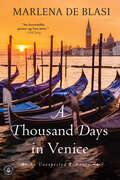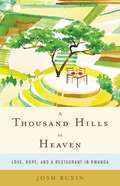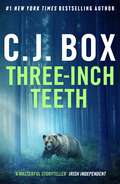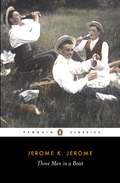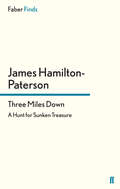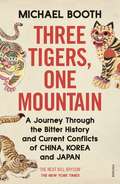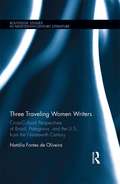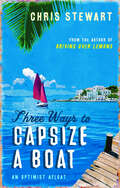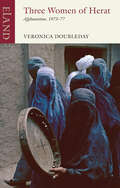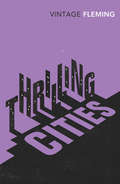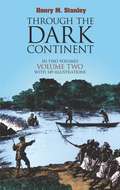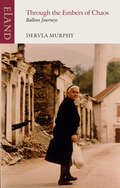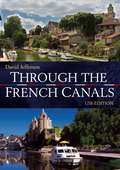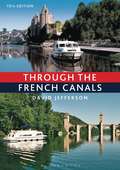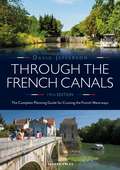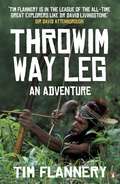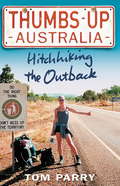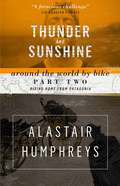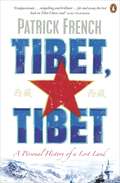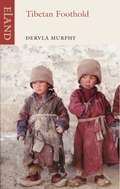- Table View
- List View
Thomas Jefferson's Paris
by Howard C. RiceThis handsomely illustrated picture book provides a remarkable glimpse of the Paris Jefferson knew—Paris on the eve of the French Revolution. The houses, gardens, bookshops, and landmarks of the time are brought to life through commentary and drawings, paintings, and maps.Originally published in 1976.The Princeton Legacy Library uses the latest print-on-demand technology to again make available previously out-of-print books from the distinguished backlist of Princeton University Press. These editions preserve the original texts of these important books while presenting them in durable paperback and hardcover editions. The goal of the Princeton Legacy Library is to vastly increase access to the rich scholarly heritage found in the thousands of books published by Princeton University Press since its founding in 1905.
Thomas, Lucy and Alatau: The Atkinsons’ Adventures in Siberia and the Kazakh Steppe
by John Massey StewartThis is the first full biography of an unjustly forgotten man: Thomas Witlam Atkinson (1799 - 1861), architect, artist, traveller extraordinaire, author – and bigamist. Famous in his lifetime as ‘the Siberian traveller’, he spent seven years travelling nearly 40,000 miles through the Urals, Kazakhstan and Siberia with special authorisation from the Tsar, producing 560 watercolour sketches – many published here for the first time - of the often dramatic scenery and exotic peoples. He kept a detailed daily journal, now extensively quoted for the first time with his descendants’ cooperation. This is also the story of Lucy, his spirited and intrepid wife and their son Alatau Tamchiboulac, called after their favourite places and born in a remote Cossack fort. They both shared his many adventures and extremes of heat and cold, travelling with him on horseback up and down precipices and across dangerous rivers, escaping a murder plot atop a great cliff and befriending the famous Decembrist exiles.
A Thousand Days in Venice: An Unexpected Romance
by Marlena de BlasiFernando first sees Marlena across the Piazza San Marco and falls in love from afar. When he sees her again in a Venice café a year later, he knows it is fate. He knows little English; she, a divorced American chef traveling through Italy, speaks only food-based Italian. Marlena thought she was done with romantic love, incapable of intimacy. Yet within months of their first meeting, she has quit her job, sold her house in St. Louis, kissed her two grown sons good-bye, and moved to Venice to marry &“the stranger,&” as she calls Fernando. This deliciously satisfying memoir is filled with the foods and flavors of Italy and peppered with culinary observations and recipes. But the main course here is an enchanting true story about a woman who falls in love with both a man and a city, and finally finds the home she didn&’t even know she was missing.
A Thousand Hills to Heaven: Love, Hope, And A Restaurant In Rwanda
by Josh RuxinOne couple's inspiring memoir of healing a Rwandan village, raising a family near the old killing fields, and building a restaurant named Heaven. Newlyweds Josh and Alissa were at a party and received a challenge that shook them to the core: do you think you can really make a difference? Especially in a place like Rwanda, where the scars of genocide linger and poverty is rampant? While Josh worked hard bringing food and health care to the country's rural villages, Alissa was determined to put their foodie expertise to work. The couple opened Heaven, a gourmet restaurant overlooking Kigali, which became an instant success. Remarkably, they found that between helping youth marry their own local ingredients with gourmet recipes (and mix up "the best guacamole in Africa") and teaching them how to help themselves, they created much-needed jobs while showing that genocide's survivors really could work together. While first a memoir of love, adventure, and family, A Thousand Hills to Heaven also provides a remarkable view of how, through health, jobs, and economic growth, our foreign aid programs can be quickly remodeled and work to end poverty worldwide.
Three-Inch Teeth (Joe Pickett)
by C.J. BoxThe thrilling new novel in the New York Times bestselling Joe Pickett series by award-winning author C.J. Box. Wyoming game warden Joe faces two different kinds of rampaging killers – one animal, one human – in this riveting adventure.A rogue grizzly bear has gone on a rampage, killing, among others, the prospective fiancé of Joe Pickett's daughter. At the same time, Dallas Cates, who Joe helped lock up, is released from prison with a list of six names tattooed on his skin. He wants revenge on the people who sent him away: the people he blames for the deaths of his entire family and the loss of his reputation and property.Targeted are his lawyer, a judge, the county prosecutor, a prison guard, Joe's associate Nate Romanowski – and Joe Pickett himself. Using the grizzly attacks as cover, Cates devises a method of violence identical to the bear killings and sets out to methodically check off his list. Can Joe stop him before he himself becomes the next target on the killer's list?Reviews for C.J Box'Box is writing at the top of his game.' Publishers Weekly'C. J. Box is among the finest and most literate authors of modern thrillers.' Bookreporter'Box's sparse and pragmatic prose is the perfect complement to the wilderness vistas Pickett knows like the back of his hand.' Providence Journal
Three Men in a Boat: To Say Nothing Of The Dog (Penguin Modern Classics)
by Jerome K. Jerome Jeremy LewisMartyrs to hypochondria and general seediness, J. and his friends George and Harris decide that a jaunt up the Thames would suit them to a 'T'. But when they set off, they can hardly predict the troubles that lie ahead with tow-ropes, unreliable weather-forecasts and tins of pineapple chunks - not to mention the devastation left in the wake of J.'s small fox-terrier Montmorency. Three Men in a Boat was an instant success when it appeared in 1889, and, with its benign escapism, authorial discursions and wonderful evocation of the late-Victorian 'clerking classes', it hilariously captured the spirit of its age.
Three Miles Down: A Hunt for Sunken Treasure
by James Hamilton-PatersonJames Hamilton-Paterson describes Three Miles Down (first published in 1998) as 'the account of a treasure hunt in 1995 which I joined as the expedition's chronicler. A group of Britons had chartered the Russian oceanographic ship, the Mstislav Keldysh, to look for the wrecks of two vessels sunk in the Atlantic in the Second World War... Both were alleged to be carrying cargoes of gold.' For the author the experience was to bring home all 'the emotions and practical technicalities of the search phase of marine salvage.' '[Hamilton-Paterson's] unfolding of the story and his deft sketching of some unusual personalities grips like the skinny hand of the Ancient Mariner.' Scotsman 'He proves to be a chronicler of the intrigue among a crew of strangers, a fount of lore about wrecks and deep-sea exploration, and a marvellous witness to the lightless wonders of profound depths.' Outside
Three Tigers, One Mountain: A Journey through the Bitter History and Current Conflicts of China, Korea and Japan
by Michael Booth'The next Bill Bryson' (New York Times) explores international relations past and present between three East Asian countries – Japan, South Korea and China – in this lively, absorbing travelogue‘Two tigers cannot share the same mountain’ - Chinese proverb China, Korea and Japan are the neighbours who love to hate each other. But why? Europe has forgiven Germany’s war crimes, why can’t Japan’s neighbours do likewise? To what extent do the ongoing state-level disputes about island ownership, war history, controversial shrines and statues, missile systems and military escalation reflect how the people of these countries regard each other? They have so much to gain from amicable relations, so why do they seem to be doing their level best to keep the fires of hatred burning? The Chinese, Koreans and Japanese are more than neighbours, they are siblings from a Confucian family. They share so much culturally, from this ancient philosophy with its hierarchical, bureaucratic legacy, to rice-growing, art, architecture, chopsticks, noodles and much more which has been passed down from China over millennia. In turn, China has modelled much of its recent industrial and economic strategy on Japan’s post-war manufacturing miracle, and adores contemporary Korean popular culture. Yet still East Asia festers with a mutual animosity which frequently threatens to draw the world into a twenty-first-century war. In his previous international best-seller, The Almost Nearly Perfect People, Michael Booth set out to explore the Scandinavian tribes and what they think of each other. In this new book, which blends popular anthropology, history, politics and travel, the subjects are these Asian tigers that have endured occupation, war and devastation to become among the richest, most developed and powerful societies on Earth. In this deeply researched, revealing book, he sets off on a journey by car, boat, train and plane through all three countries, ending up in a fourth, Taiwan. Here, he hopes to find a positive story but instead discovers the Taiwanese are not merely in conflict with the Chinese, but they also harbour another, less well-known but still bitter grudge towards an East Asian neighbour.
Three Traveling Women Writers: Cross-Cultural Perspectives of Brazil, Patagonia, and the U.S from the Nineteenth Century (Routledge Studies in Nineteenth Century Literature)
by Natália Fontes de OliveiraThis book presents an alternative framework for reading nineteenth century women’s travel narratives by challenging the traditional paradigms which often limit women’s space in print culture. For the first time, through a comparative lens, a Latin American woman’s travel narrative is analyzed concomitantly with the narratives of a North American and a European writer. Contrary to the common assumption that Latin American women were powerless victims of imperialism, elite women had access to the predominant philosophies of their time, traveled around the globe, and wrote about their experiences. This book examines how an Argentinian writer, together with an English and an American writer, manipulate their bourgeois identity to inhabit the male dominated sphere of print culture. By travelling and publishing travel narratives, the three traveling women writers search for empowerment to establish their authority as writers and shapers of knowledge in literature. Utilizing several concepts and criticisms, including Aristotle’s rhetoric, Foucault’s theories, travel writing criticism, postcolonial discourse, and feminist literary criticism; this volume attempts to challenge old-fashioned architypes and confinements of gender for traveling women writers in the nineteenth century.
Three Traveling Women Writers: Cross-Cultural Perspectives of Brazil, Patagonia, and the U.S from the Nineteenth Century (Routledge Studies in Nineteenth Century Literature)
by Natália Fontes de OliveiraThis book presents an alternative framework for reading nineteenth century women’s travel narratives by challenging the traditional paradigms which often limit women’s space in print culture. For the first time, through a comparative lens, a Latin American woman’s travel narrative is analyzed concomitantly with the narratives of a North American and a European writer. Contrary to the common assumption that Latin American women were powerless victims of imperialism, elite women had access to the predominant philosophies of their time, traveled around the globe, and wrote about their experiences. This book examines how an Argentinian writer, together with an English and an American writer, manipulate their bourgeois identity to inhabit the male dominated sphere of print culture. By travelling and publishing travel narratives, the three traveling women writers search for empowerment to establish their authority as writers and shapers of knowledge in literature. Utilizing several concepts and criticisms, including Aristotle’s rhetoric, Foucault’s theories, travel writing criticism, postcolonial discourse, and feminist literary criticism; this volume attempts to challenge old-fashioned architypes and confinements of gender for traveling women writers in the nineteenth century.
Three Ways to Capsize a Boat: An optimist afloat
by Chris StewartIf you're wondering what Chris Stewart did before he and Ana moved to El Valero, their Spanish farm, here's one of the answers. He took to the sea, landing a job as skipper for the summer, sailing a Cornish Crabber around the Greek islands. It was his dream job - and there was just one tiny problem. He hadn't ever sailed before and had not the foggiest how to start. In a series of madcap and hilarious adventures we follow Chris from a shaky start in Chichester harbour to his epic Odyssey to Spetses (a bucket would have been handy), and then on to the journey of a lifetime - battening down the hatches on a trip across the North Atlantic. It's a journey crackling with Chris's zest for life, irresistible humour, and unerring lack of foresight. Dry land never looked more welcoming. Chris Stewart shot to fame with Driving Over Lemons - Sort Of Books' launch title in 1999. Funny, insightful and real, the book told the story of how he bought a Spanish peasant farm on the wrong side of the river, with its previous owner still resident. It became an international bestseller and together with its sequels - A Parrot in the Pepper Tree and The Almond Blossom Appreciation Society -has sold more than a million copies in the UK alone. Chris prepared for life on his Spanish farm with jobs of doubtful relevance. He was the original drummer in Genesis (he played on the first album), then joined a circus, learnt how to shear sheep, went to China to write the Rough Guide, gained a pilot's license in Los Angeles, and completed a course in French cooking. Three Ways to Capsize a Boat fills in his lost years as a yacht skipper in the Greek islands and dodging icebergs in the Atlantic. It is that rare thing: a book about sailing equally fun for people without a trace of sea legs. Chris, his wife Ana and their daughter Chloëcontinue to live on their farm, with their numerous dogs, cats, chickens, sheep and misanthropic parrot.
Three Women of Herat: Afghanistan, 1973–77
by Veronica DoubledayIt’s Afghanistan before the Soviet invasion, and Veronica Doubleday and her husband settle in Herat, where John is planning to study the local musical tradition. Veronica makes friends with three very different young women, slowly immersing herself in the unfamiliar world of Herati female culture. Although constrained by tradition, these women are far from submissive, each skilfully exerting influence in the management of their lives. They welcome Veronica into their homes and include her in family events and celebrations. It’s a world of intense friendships, music-making, support and laughter, as well as illness, hardship and sadness. Veronica inhabits their world without judgement, even wearing a veil herself, and gives us rare, deep and privileged access to a hidden realm.
Thrilling Cities
by Ian FlemingOn November 2nd armed with a sheaf of visas...one suitcase...and my typewriter, I left humdrum London for the thrilling cities of the world...In 1959, Ian Fleming, the creator of James Bond, was commissioned by the Sunday Times to explore fourteen of the world’s most exotic cities. Fleming saw it all with a thriller writer’s eye. From Hong Kong to Honolulu, New York to Naples, he left the bright main streets for the back alleys, abandoning tourist sites in favour of underground haunts, and mingling with celebrities, gangsters and geishas. The result is a series of vivid snapshots of a mysterious, vanished world.
Through the Dark Continent: Vol. 2
by Henry M. StanleyPerhaps best known as the intrepid adventurer who located the missing explorer David Livingstone in equatorial Africa in 1871, Henry Morton Stanley (1841-1904) played a major role in assembling the fragmented discoveries and uncertain geographical knowledge of central Africa into a coherent picture. He was the first European to explore the Congo River; assisted at the founding of the Congo Free State, and helped pave the way for the opening up of modern Africa.In this classic account of one of his most important expeditions, the venerable Victorian recounts the incredibly difficult and perilous journey during which he explored the great lakes of Central Africa, confirming their size and position, searched for the sources of the Nile, and traced the unknown Congo River from the depths of the continent to the sea. Accompanied by three Englishmen and a crew of Africans, Stanley left Zanzibar in 1874. He traveled to Lake Victoria, which he circumnavigated in his boat, the Lady Alice. Almost immediately, illness, malnutrition and conflicts with native tribes began to decimate his followers. Nevertheless, the explorer pushed on, also circumnavigating Lake Tanganyika, which he determined to be unconnected with the Nile system. Finally in 1876, Stanley was ready to undertake "the grandest task of all" — exploring the Livingstone (Congo) River. He sailed down the vast waterway to the lake he called Stanley Pool, then on to a series of 32 cataracts he named Livingstone Falls. Unable to go further by boat, Stanley continued overland, reaching the Atlantic Ocean on August 12, 1877. Mishaps, hostile tribes, and disease had killed his three white companions and half the Africans, but Stanley had attained his objective.His tremendous perseverance (his persistence led his men to nickname him Bula Matari — "the rock breaker") was complemented by Stanley's abilities as a keen observer and accomplished prose stylist. These talents are fully evident in this exciting narrative. It offers not only the action and adventure of a life-and-death struggle to survive in the African wilderness, but detailed descriptions of native peoples, customs, and culture; the flora and fauna of central Africa; and a wealth of geographical, ecological, and other information. Supplemented with 149 black-and-white illustrations and a foldout map, this monumental narrative will be welcomed by anyone interested in the European exploration of central Africa during the nineteenth century, the exploits of one of the great explorers of all time, and a breathtaking story of human endurance and achievement in the face of immense odds.
Through the Embers of Chaos: Balkan Journeys
by Dervla MurphyAs Dervla Murphy crisscrossed the Balkans in a series of bicycle journeys towards the beginning and end of the 1990s, she recorded the griefs and confusions of the ordinary people, many of whom had showed extraordinary courage and resilience during that terrible ‘decade of decay’ and whose voices were so little heard during the conflict. Despite their suffering, she found plenty of traditional Balkan hospitality and was passed between friends from city to city and town to town. Through the Embers of Chaos describes journeys – through Croatia, Servia, Bosnia-Herzegovina, Montenegro, Kosovo and Albania – that demanded the greatest emotional and physical stamina, while also elucidating the complex history of the both the region and the conflict itself. It’s an extraordinary achievement.
Through the French Canals
by David JeffersonThrough the French Canals has probably tempted more people to explore the beautiful waterways of France than any other book. A bestseller for many years and now in its 12th edition, it is the essential planning guide for anyone wanting to cruise through the stunning scenery of the French waterways, or take their boat from the English Channel through to the Mediterranean via the inland route. Over 50 routes described and illustrated, with positions of locks, towns and villages Through routes from the English Channel and Atlantic to the Mediterranean, plus distances Suitable boats for the canals, and dimensions of locks and operating times Bridge heights, canal depths, fuelling points, waterway signals Cost of living, shopping and stores Weather information, haltes and portes de plaisancePacked with appealing photographs and updated information on local facilities, distances, heights and depths, tunnel lengths, costs of cruising and shopping, it also discusses the local wines of the region.'A must for yachtsmen wishing to use the French inland waterway system...a fascinating read.' Yachting Monthly'The bible for those wishing to head for the Med.' Gaffer's Log
Through the French Canals
by David JeffersonThrough the French Canals has probably tempted more people to explore the beautiful waterways of France than any other book. A bestseller for many years and now in its 13th edition, it is the essential planning guide for anyone wanting to cruise through the stunning scenery of the French waterways, or take their boat from the English Channel down to the Mediterranean via the inland route.- Over 50 routes described and illustrated, with positions of locks, towns and villages- Through routes from the English Channel and Atlantic to the Mediterranean, plus distances- Suitable boats for the canals, and dimensions of locks and operating times- Bridge heights, canal depths, fuelling points, waterway signals- Cost of living, shopping and stores- Weather information, haltes and portes de plaisance- Port plans for Paris, Dunkerque and StrasbourgPacked with appealing photographs and updated information on local facilities, distances, bridge heights and depths, tunnel lengths, costs of cruising and shopping, it also discusses the local wines of the region.
Through the French Canals (Travel Ser.)
by David JeffersonThrough the French Canals has probably tempted more people to explore the beautiful waterways of France than any other book. A bestseller for many years and now in its 13th edition, it is the essential planning guide for anyone wanting to cruise through the stunning scenery of the French waterways, or take their boat from the English Channel down to the Mediterranean via the inland route.- Over 50 routes described and illustrated, with positions of locks, towns and villages- Through routes from the English Channel and Atlantic to the Mediterranean, plus distances- Suitable boats for the canals, and dimensions of locks and operating times- Bridge heights, canal depths, fuelling points, waterway signals- Cost of living, shopping and stores- Weather information, haltes and portes de plaisance- Port plans for Paris, Dunkerque and StrasbourgPacked with appealing photographs and updated information on local facilities, distances, bridge heights and depths, tunnel lengths, costs of cruising and shopping, it also discusses the local wines of the region.
Through the French Canals: The Complete Planning Guide to Cruising the French Waterways
by David JeffersonThrough the French Canals has probably tempted more people to explore the beautiful waterways of France than any other book. First published in 1970, it's been the key authoritative title on cruising the French canals ever since. The revised new edition is the essential comprehensive planning guide for anyone wanting to cruise through the French waterways or take their boat from the English Channel through to the Mediterranean via the inland route. It includes: over 50 routes fully described and illustrated, with positions of locks, towns and villages through routes from the English Channel and Atlantic to the Mediterranean, plus distances, and assessment of suitable boats for the canals. It also provides dimensions of locks and operating times, details of bridge heights, canal depths, fuelling points, waterway signals, a guide to the cost of living, shopping and stores, sources of weather information, haltes for overnight stops, and ports de plaisance. As well as new photography, the new edition is updated throughout with new information on local facilities, new haltes and ports de plaisance, new VNF License fees, revisions to cruise hire companies, updated references to holding tanks, the availability of diesel and costs of cruising and much more.
Through the French Canals: The Complete Planning Guide to Cruising the French Waterways
by David JeffersonThrough the French Canals has probably tempted more people to explore the beautiful waterways of France than any other book. First published in 1970, it's been the key authoritative title on cruising the French canals ever since. The revised new edition is the essential comprehensive planning guide for anyone wanting to cruise through the French waterways or take their boat from the English Channel through to the Mediterranean via the inland route. It includes: over 50 routes fully described and illustrated, with positions of locks, towns and villages through routes from the English Channel and Atlantic to the Mediterranean, plus distances, and assessment of suitable boats for the canals. It also provides dimensions of locks and operating times, details of bridge heights, canal depths, fuelling points, waterway signals, a guide to the cost of living, shopping and stores, sources of weather information, haltes for overnight stops, and ports de plaisance. As well as new photography, the new edition is updated throughout with new information on local facilities, new haltes and ports de plaisance, new VNF License fees, revisions to cruise hire companies, updated references to holding tanks, the availability of diesel and costs of cruising and much more.
Throwim Way Leg: An Adventure
by Tim FlanneryThrowim Way Leg is a book of wonder and excitement, struggle and sadness, a love letter to Papua New Guinea and Irian Jaya. 'In New Guinea Pidgin,' Tim Flannery explains, 'throwim way leg means to go on a journey. It describes the action of thrusting out your leg to take the first step of what can be a long march...' Here he invites us to share in his breathtaking adventures, as he meets skilled hunters and befriends a shaman, climbs mountains never before scaled by Europeans, discovers new species and, deep in the jungle, stumbles across the giant bones of extinct marsupials. He also writes movingly about the fate of indigenous people when their intricate cultures collide with mining companies and the high-tech modern world.'This book combines an irresistible author with an irresistible subject: Tim Flannery, a great zoologist and writer about science, relating his explorations of New Guinea, a vivid tropical universe' Jared Diamond'An enthralling introduction to the mountain people of New Guinea - unimaginably remote, charming, cunning, cruel, subtle and appealing - and to their magnificent land' New York Times Book ReviewTim Flannery is an internationally acclaimed writer, scientist and explorer. As a field zoologist he has discovered and named more than thirty new species of mammals, including two tree-kangaroos. His books include Country and the award-winning international bestsellers The Future Eaters, The Eternal Frontier and The Weather Makers. He has also edited and introduced many historical works, including The Birth of Sydney, The Diaries of William Buckley and The Explorers.
Thumbs Up Australia: Hitchhiking the Outback
by Tom ParryOn the Road meets Down Under in this really rough guide to the adventures of an enthusiastic hitchhiker and his reluctant girlfriend on their quest for the real Australia. Hitching lifts with the desert's dodgiest drivers and taking breaks in the roughest roadhouses, this is Tom Parry's witty, warts-and-all tale of hitchhiking 8,000 miles across - and around - the Australian outback with his thumb, his backpack and his French girlfriend, Katia. As the couple hitch their way around the near empty highways, they encounter as wide a cross-section of Aussie society as you could ever hope to meet. In cattle stations, Aboriginal communities, remote waterholes, caravan parks, hippy communes and roadhouses, they see a country that remains as extraordinary today as it was for the first nineteenth century settlers. Loosely following the routes carved out by the legendary explorers who first traversed the great continent, the couple get to grips with the country's fascinating history. Set against a backdrop of the real Australia - not 'as seen on TV'- "Thumbs Up Australia" is full of wonderful anecdotes and endearing tales of some of the country's most idiosyncratic characters, from the grizzled Aboriginal elder with his tales of dreamtime, to an amphetamine-swallowing road train driver. And at the end of their journey, it is ironically Katia who suggests thumbing a lift to the airport!
Thunder and Sunshine: Around the World by Bike Part Two: Riding Home from Patagonia (2nd edition) (Around The World By Bike Ser.)
by Alastair HumphreysAt the age of 24, Alastair Humphreys set off to try to cycle round the world. By the time he arrived back home, four years later, he had ridden 46,000 miles across five continents on a tiny budget of just £7,000. THUNDER AND SUNSHINE is the sequel to the best-selling Moods of Future Joys. Here Humphreys sails from Africa to South America, where he rides from the southern tip of Patagonia to northern Alaska. Crossing the Pacific, he cycles into a Siberian winter, carries on through Japan, China and nearing the end of his journey at last, across Asia and Europe towards his home in Yorkshire.
Tibet, Tibet: A Personal History of a Lost Land (Vintage Departures Ser.)
by Patrick FrenchTibet has long fascinated the West, but what really lies beyond our romantic image of a mystical mountain kingdom of peace and spirituality? Patrick French set out to discover the truth, and his extraordinary account has been widely acclaimed.Travelling through the country, French meets exiled monks, nomads and a nun secretly fighting Chinese rule, but also young Tibetans with a more pragmatic attitude to their situation. Interweaving these encounters with little-known stories of war and turmoil from Tibet's past, he reveals a more nuanced, fascinating and surprising picture of this complex place than any other book has done.
Tibetan Foothold
by Dervla MurphyAfter her epic journey from Ireland to India by bicycle in 1963, Dervla Murphy immersed herself in the life of the sub-continent, working for six months in an orphanage for Tibetan children in Northern India. She fell in love with the 'Tiblets' - the cheerful, uncomplaining, independent and affectionate children of the new Tibet-in-exile - but she also managed to explore India's Tibetan frontier, leaving the reader panting in her wake. Alongside her enchantment, Dervla became a perceptive witness to the realities of aid work: the corruption, smug piety and power struggles of the bureaucrats, and the dangerous, long-term side effects on the recipients - cultural enfeeblement and dependency. Tibetan Foothold not only confirmed Dervla's status as a traveller, but also revealed her to be a truly independent voice and an acute observer of politics and society.
